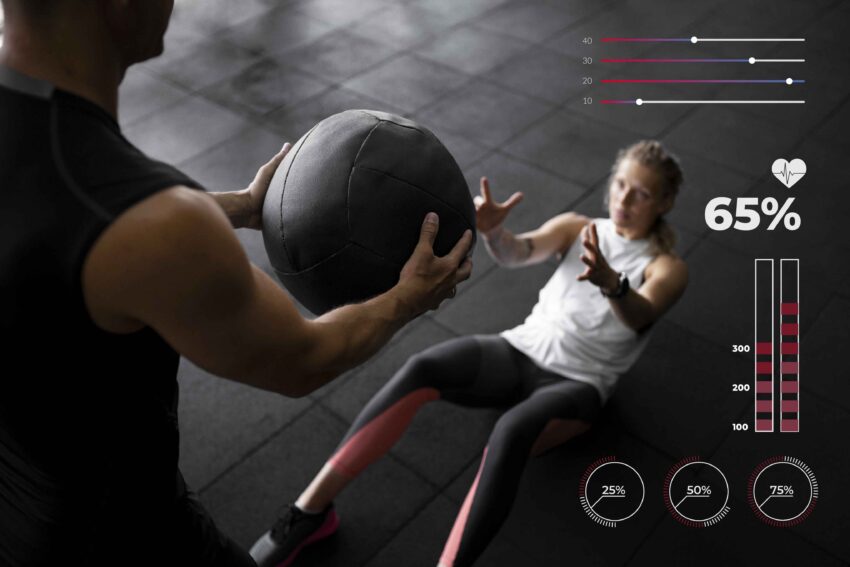High-Intensity Interval Training (HIIT) Workout: Benefits and Best Practices
What is HIIT?
HIIT workout has revolutionized the world of fitness. due to its efficient and optimal way to improve your physical fitness and overall health. High-intensity interval training exercise is a training technique in which you give all your efforts for a short period, also including a period of rest to speed up muscle recovery. Usually consists of a rest period of 15 seconds to 4 minutes, during which a quick recovery of muscles is ensured.
Some basic examples are 30 sec of sprint + 30 sec of rest repeat it 10 times, 45 sec of jumping jacks + 15 sec of rest repeat it 12 times. The total workout lasts between 4 min to 20 min, all exercise is done with a long intensity in a short period. Not only does it help you burn calories faster, but it also affects your overall health, increases muscle strength, and has countless benefits. In this article, we will provide the best ways to help you incorporate this exercise into your fitness routine.
How Does HIIT Work?
During High-intensity interval training exercise your heart rate increases and reaches higher levels, which improves your cardiovascular fitness and helps you burn calories more efficiently. The subsequent rest periods normalize your heart rate promote recovery and keep you going until the end of your workout.
HIIT boosts your metabolism, which keeps burning calories even after the workout is over, this process is called the afterburn effect or excess post-exercise oxygen consumption (EPOC).
“Benefits of (HIIT) Workout”
1. Time Efficiency
In today’s fast-paced world, it is very difficult to find time for exercise to stay fit. One of the most important benefits of HIIT workouts is that it is time efficient. HIIT sessions are typically shorter than traditional workouts, A session lasts 20 to 30 minutes and the intensity of the exercise is done in a very efficient manner in this short period, making it possible to get unlimited fitness benefits in a limited amount of time.
2. Improved Cardiovascular Health
HIIT workout is one of the most effective ways to improve your cardiovascular health. Intense exercise increases your heart pumping significantly, which improves heart function and strengthens your heart, which in turn lowers your blood pressure. It can lower your cholesterol levels and improve your bad cholesterol levels, keeping your good cholesterol levels up regularly. Studies show that HIIT improves your heart health more than traditional exercise.
3. Increased Calorie Burn
HIIT workouts are effective in burning more calories in less time than other traditional exercise. High-intensity interval training raises your heart pumping rate and increases your metabolism rate, which burns calories during the exercise, and also during the rest period after the exercise. By burning more calories through the after-burn effect, it removes waste materials from the body in the form of sweat, decreases fat levels from your body, and makes your muscles stronger.
4. Fat Loss and Muscle Preservation
HIIT workout reverses the loss of body fat while increasing and preserving lean muscle in the body more than other exercises or pieces of training. Intense Interval training to lose your belly fat stimulates muscle growth and strength, giving you a lean and toned body and enhancing your physique.
5. Improved Insulin Sensitivity
HIIT workouts can improve insulin sensitivity in anyone. It is especially effective for people with insulin resistance and type 2 diabetes. High-intensity interval training exercise improves insulin sensitivity means your muscles can use glucose more efficiently for energy. It has beneficial effects on blood sugar levels and protects against type 2 diabetes.
6. Enhanced Aerobic and Anaerobic Capacity
HIIT workouts improve both your aerobic (endurance) and anaerobic (high-intensity) abilities. These high-intensity interval training exercises increase your aerobic capacity, allowing you to perform high-intensity exercises for longer periods. As well as boosts your overall anaerobic capacity, improves your ability to maintain moderate exercise, and improves your stamina.
7. Convenience and Flexibility
HIIT workout is very convenient and flexible. It is an exercise that can be done with minimal equipment and can be done almost anywhere. You can also perform these exercises with your body weight, such as chin-ups, pull-ups, and planks anywhere in your home or office.
Along with cycling, jogging, running, and some gym equipment such as dumbbells, kettle-bells and with these resources you can make your workout very effective and perform properly.
“Best Practices for HIIT”
To get the most benefits of this High Intense Interval training exercise and minimize the risk of injury, it’s essential to follow best practices and incorporate this exercise into your fitness routine effectively. Follow a few methods to perform this exercise effectively. Here are some important tips to add HIIT into your daily routine:
1. Warm-Up Properly

Always prepare your body for a HIIT workout with a proper warm-up. Start your workout with a warm-up. A good warm-up should increase your heart rate, loosen your muscles, and improve your body’s range of motion. Do at least 5 to 10 minutes of dynamic stretches and light cardio exercises such as jogging, jumping jacks, push-ups, and chin-ups.
2. Start Slow and Progress Gradually
If you are new to HIIT workouts. You need to start your training with short intervals and low intensity, and when it becomes easy for you, then you can increase your training intervals and the intensity of the exercise. In this way, you will achieve the goal of a HIIT workout.
For example, you can do one set of intense workouts for 30 seconds, then take a 60-second rest, and then reduce the rest time after some days.
3. Focus on Form and Technique
Paying high attention to the forms and techniques of this exercise. As it is extremely important for muscle strength, it not only prevents you from serious injuries but also targets the right muscle groups. So, be mindful of your posture, alignment, and movement patterns during HIIT workouts. If you are not confident about your form and technique then you need to take guidance from a fitness expert or you can also take guidance from fitness tutorial videos.
4. Include a Variety of Exercises
To make your HIIT workout interesting and challenging, add different variety of exercises in your fitness routine that target different muscle groups such as bodyweight exercises (push-ups, squats, chin-ups), and cardio activities (sprints and cycling), and also strengthen training (like kettlebell swings, dumbbell presses, and weightlifting). Add these high-intensity exercises to your daily workout routine to keep you consistent as they eliminate boredom and lead to muscle growth.
5. Listen to Your Body
When your HIIT workout becomes too challenging or hard for you, it’s important to listen to your body and avoid overexerting yourself. Adjust your exercise intensity according to your strength. If you are feeling very tired, take a rest day or choose a low-intensity exercise to allow your body to recover, as you are a human, not a robot.
6. Cool Down and Stretch
Take time to cool down your body temperature, and stretch your muscles after the HIIT workout session. A proper cool-down relaxes you and gradually lowers your heart rate. Cooling down is very beneficial for your muscle health. After the HIIT workout session do at least five to ten minutes of dynamic stretches and focus on the major muscle groups that were focused in the session, this will help reduce muscle soreness and improve flexibility.
7. Fuel Your Body Properly
Nutrition plays an important role in strengthening your body and is an important part of your HIIT workout plan and overall health. Nutrition helps you in achieving your fitness goals.
Make sure you are fuelling your body with a balanced diet rich in nutrients. Include these important nutrients in your meals like carbohydrates for energy, protein for muscle recovery, and healthy fats for your brain function. Also, stay hydrated by drinking plenty of water throughout the day. Because water contributes to your healthy digestion of meals.
8. Incorporate Rest and Recovery
Rest is the time when your body recovers and rebuilds your muscle’s broken tissues, it is the time when your muscles become stronger, strong, and big. Along with exercise, rest plays a huge role when it comes to bodybuilding and strengthening your body. Rest is also a high demand of your body. Rest is the only phase when your muscles recover. Over-training can lead to injuries and can hinder your muscle growth, so it’s important to listen to your body. And take rest for a proper healthy body.
9. Consult a Professional
It’s not recommended to hire a fitness consultant, but if you want to do HIIT workouts properly, then consult with a fitness professional or your trainer before trying any new fitness techniques. They can help you design a high-intensity interval training program based on your fitness level, goals, and interests.
Sample HIIT Workout
Here are some samples of HIIT workouts that you can adjust the duration and intensity of this exercise according to your fitness level and goals. Here are three sample workout plans that you can follow according to your level of fitness.
Beginner HIIT Workout
Warm-Up:
5 minutes of light cardio (treadmill running, cycling)
Workout:
- 30 seconds of jumping jacks
- Thirty seconds of rest
- 30 seconds of bodyweight squats
- Thirty seconds of rest
- 30 seconds of push-ups
- Thirty seconds of rest
- 30 seconds of high knees
- Thirty seconds of rest
- 20 reps of lunges
- 30 seconds of rest
Sets:
Repeated every set 3-4 times per session.
Cool Down:
5 minutes of stretching after a workout.
Intermediate HIIT Workout
Warm-Up:
5 minutes of light cardio (jogging, dynamic stretches)
Workout:
- 40 seconds of burpees
- 20 seconds of rest
- 40 seconds of alternating lunges
- 20 seconds of rest
- 40 seconds of mountain climbers
- 20 seconds of rest
- 40 seconds of plank to push-up
- 20 seconds of rest
Sets:
Repeated every set 4-5 times per session.
Cool Down:
5-10 minutes of stretching.
Advanced HIIT Workout
Warm-Up:
5-10 minutes of light cardio (Pull-ups, jogging, dynamic stretches)
Workout:
- 45 seconds of sprinting
- 15 seconds of walking/rest
- 45 seconds of kettlebell swings
- 15 seconds of rest
- 45 seconds of plyometric push-ups
- 15 seconds of rest
- 45 seconds of box jumps
- 15 seconds of rest
Repeat:
5-6 times every set.
Cool Down:
5-10 minutes of stretching.


1 thought on “Benefits and Best Practices of High-Intensity Interval Training (HIIT) Workout”